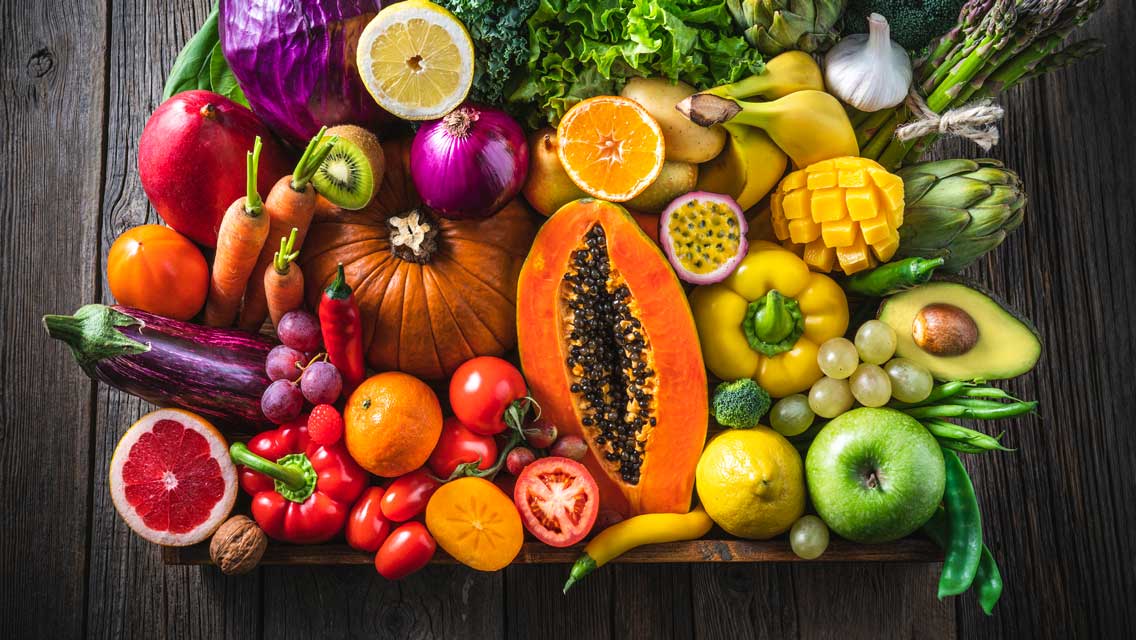Tomatoes
High in an antioxidant phytochemical called lycopene, tomatoes support your skin, eyes, and cardiovascular system and have anticancer properties. They’re also a bountiful source of the immune-system-supporting nutrients quercetin, lutein, and vitamins A, C, and E.
Optimize: The seeds and skins provide about 50 percent of tomatoes’ vitamin C and lycopene. Unless you’re dealing with specific autoimmune challenges, you can enjoy tomatoes fresh. Long-simmering tomato sauce can triple tomatoes’ lycopene content, making this one food that’s even more nutritious when cooked.
Mitigate: To reduce alkaloids that may irritate a sensitive immune system, remove the seeds and skin, and pressure-cook tomatoes. (Or simply cook them down.) Many people with autoimmunity find they can tolerate tomatoes this way.
Swap: If you’re avoiding tomatoes, try using a different acidic fruit in salads, such as grapefruit. For something sweet and colorful in salsas and sauces, consider beets. You can always add a little lemon or vinegar to provide acid where needed.
Peppers
Sweet bell peppers, as well as spicy cayenne peppers and other chili peppers, belong to the nightshade family. (The black-pepper plant is not a nightshade.) Some of the most nutrient-dense foods available, bell peppers deliver vitamins C, K, and B6, as well as folic acid and a host of phytochemicals. Capsaicin, the same compound in chili peppers that brings the heat, is an effective pain reliever and offers cardiovascular benefits.
Optimize: Enjoy peppers raw, roasted, or sautéed. Eating bell peppers raw preserves their vitamin C, but some research suggests that cooking may increase their antioxidant benefits.
Mitigate: To reduce alkaloid content, remove the seeds. Conventionally grown bell and hot peppers may contain concerning levels of organophosphate insecticides, according to the Environmental Working Group, so buy organic when you can.
Swap: Try carrots, cucumbers, and celery for other colorful, crunchy snacks. It’s hard to replicate the heat of spicy peppers, but you can swap in other bold ingredients, such as olives, vinegar, and citrus zest.
Potatoes
French fries aside, potatoes have a lot to offer in terms of nutrition. Note that sweet potatoes and yams are not nightshades. (For more, see “The Health Benefits of Eating Potatoes“.)
Optimize: When potatoes are cooked and allowed to cool, their starch transforms into resistant starch, a form of carbohydrate that nourishes the beneficial bacteria in your gut.
Mitigate: Buy organic whenever you can. Conventionally grown potatoes are sprayed with fungicides and pesticides and treated with sprout inhibitors during storage. You can eliminate up to 70 percent of toxic residue, and substantially reduce alkaloid content, by peeling them. (The alkaloids are concentrated in the skin.)
On that note, avoid eating potatoes that have started to turn green; that color is caused by increasing alkaloids in the skin, which increases their bitterness and can cause stomach upset.
Swap: It’s surprisingly easy to swap in other root veggies, such as sweet potatoes, turnips, parsnips, and celeriac, as well as cauliflower, in recipes and as sides.
Eggplants
Underappreciated in the United States, various eggplant varieties are staples in Asian and Mediterranean cuisines. They’re a great source of fiber, and the glossy purple skin contains cancer-fighting antioxidants called anthocyanins.
Optimize: Because the deeply hued skin of purple eggplant is such a rich source of nutrients, look for varieties with thin and tender skin; some varieties have unappetizing tougher skins.
Mitigate: Alkaloids in eggplants are what cause the bitter flavor; look for sweeter varieties such as Chinese, Japanese, or Thai.
Fresher eggplants are often less bitter as well. Salting, while masking the bitterness of eggplants, does not remove the alkaloids. Cooking may diminish solanine’s toxicity.
Swap: For a silken texture that resembles that of eggplant, try portobello mushrooms or thick-sliced zucchini or other summer squash.
Depending on the recipe, root vegetables, such as rutabagas, turnips, and celeriac can also make good substitutes for eggplant. (Still skeptical? Try this recipe for Baba Ghanoush where you roast the eggplant which gives it a nutty flavor.)
This was excerpted from “How to Navigate Nightshade Foods” which was published in the July/August 2022 issue of Experience Life.





This Post Has One Comment
I have severe arthritis and psoriasis. I have found nightshades are not good for me — although I love them. The section in this article on how to mitigate the effect of nightshades is so helpful!